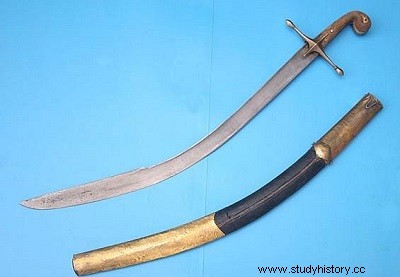
A scimitar is a type of saber with a curved blade mainly used in West Asia (Middle East). »
There is very little information on the exact geographical origin of the scimitar. But everything seems to indicate that scimitar-shaped weapons were developed from those used by the Macedonians under Alexander the Great, such as the "Kopis" sword which itself derives from the Egyptian "Khepesh" sword.
The curved sword called "shamshir" did not exist in the Middle East before the 13th century. Its main particularity is the content of its steel, sometimes in Damascus steel from wrought or crystallization which gives it extreme hardness and flexibility, without breaking.
The main place of manufacture of these blades is Persia, Shamshir means:"lion's tail" in Persian. Its period of full expansion goes from the 16th to the 19th century in Persia and the Ottoman Empire.
Description
Its curved blade makes it a very special weapon and it requires a totally different approach than a normal sword. If it is considered one of the best known and most terrifying swords in history, it is due to the fact that Muslims used it in many of their conquests.
The interest of such a weapon is that its curved blade made it possible to slide on hard surfaces (armor, chainmail, etc.) and made it possible to resume a missed attack. It's a pretty fast blade. Additionally, due to the curvature of the blade, the saber cut through tissue where a straight sword would jam, preventing a larger wound from being created. Its devastating effects on the battlefield were beyond doubt.
The weapon sometimes reaches 90 cm (more than 70 for the blade). The blade has a single cutting edge and it ends in a very effective point for thrusting blows, the cutting blows being reinforced by the widening and weighting of the blade towards the point. There are still scimitars with flamed blades, quillons straightened towards the point, etc. It should be noted that in the broad sense, the word "scimitar" refers to all Middle- or Near-Eastern swords.
Used with a circular shield by slashing riders exclusively, it survived the appearance of firearms as an auxiliary weapon for several centuries.
